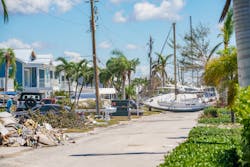A healthcare system and its laboratories’ experience with Hurricane Ian
The same week that Category 4 Hurricane Ian made landfall in Florida, researchers from the Center for Climate, Health and the Global Environment, Harvard T.H. Chan School of Public Health in Boston published their systematic assessment of hurricane risk to United States hospital-based healthcare delivery. Published in the October 2022 edition of GeoHealth, the study revealed:1
- A total 25 of 78 metropolitan statistical areas (MSAs) on the U.S. Atlantic and Gulf Coasts have half or more of their hospitals at risk of flooding from relatively weak hurricanes.
- The 0.82 m of sea level rise expected within this century from climate change increases the odds of hospital flooding 22%.
- In 18 MSAs, at least half of the roads within 1.6 km of hospitals were at risk of flooding from a Category 2 cyclone.
In their conclusion, they state: “Many cities and healthcare systems in the United States are shoring up resilience to extreme events, but more work is needed…The prospect of more probable and severe hurricane strikes in regions lesser experienced with hurricanes, such as the Northeast, underscores the importance of sharing best practices and standardized approaches to hurricane preparedness and response.”
Hurricane Ian, which was the deadliest hurricane to strike Florida since 1935, made landfall on the west coast of the state on September 28, 2022. This was followed by Hurricane Nicole, the first hurricane in 40 years to hit the United States during the month of November, striking Florida’s east coast on November 10, 2022. Both caused significant flooding and damage.
All U.S. healthcare organizations have some level of emergency planning procedures required through federal regulations and accreditors, such as The Joint Commission. But were existing procedures adequate for responding to Hurricane Ian, and are hospitals rethinking their preparedness strategies given the devastating impact of Ian?
MLO interviewed Lynn Gott, MHA, MT(ASCP), System Director, Laboratory Services for Lee Health in Southwest Florida, which was in the direct path of Hurricane Ian, on the organization’s emergency preparedness plan, which elements were most helpful during the devastating Category 4 storm, and her advice to other lab leaders on both preparing for an emergency and maintaining operations during one.Preparing for continuous lab coverage
Patients continue to require medical care and lab testing regardless of what is happening outside the four walls of a hospital; therefore, a continuity plan for lab operations is an emergency plan essential.
“Our Lab Hurricane Plan is structured around the Lee Health System Hurricane Response Plan,” said Gott. “An Incident Command System is set up for the entire health system to coordinate efforts. Disaster management training is provided for the leadership team and a needs assessment is conducted.”
Lee Health’s laboratory hurricane plan defines essential staff (those who perform critical patient care and operations functions) as either Team A or Team B (primarily in the acute care settings).
When the Code Brown Hurricane Warning is called by the health system in coordination with the Lee County Emergency Operations Center (EOC), Team A members must report on site at a designated time and remain until the storm has passed and the “all clear” is called.
“Team A is told that they could be deployed as long as 5 days,” Gott explained. “They are paid for all hours they are on site, including sleep time (excluding shift differential).
Those individuals assigned to Team B are expected to maintain lab operations prior to the arrival of Team A to allow Team A members to leave work and prepare for the storm (e.g., secure their homes, gather necessary supplies to bring with them such as bedding, snacks, water, etc.). After the “all clear” is called and it is safe to travel, Team B is expected to report into the facility to relieve Team A (preferably within 3 hours).
“Assignment to hurricane teams is voluntary (A or B) whenever possible unless there is not a balance to provide continuous coverage of the lab 24/7 before, during, and after the storm,” Gott explained. “This is the responsibility of the lab leaders at each respective location.”
Lee Health’s Laboratory Hurricane Plan also includes a section to address lab relocation if the lab must evacuate to a safer part of the facility due to flooding or wind. In the event this happens, certain equipment and supplies would be moved to the new temporary lab location in accordance with the Hurricane Relocation Checklist document that is an addendum to the Hurricane Plan. During relocation, lab staff would offer a limited test menu until they return to the lab.
Weathering Hurricane Ian
Lee County, Florida, where Lee Health is based, took a direct hit from Hurricane Ian, resulting in widespread evacuations, more than 50 deaths, and destruction of critical community infrastructure.
“All facilities were placed on lockdown during the storm and all individuals in the facility had to be registered and wear a wristband to keep track of who was in the building,” said Gott. “There were frequent department huddles and leadership meetings held during the storm and afterwards to keep everyone informed of what was happening in the facility and across the system.”
Severe damage to Lee County’s utilities occurred because the storm surge shifted buried water pipes, causing them to crack and develop leaks. The community was without running water because of a water main break, and the extensive work to fix the system and flush it of contaminants meant weeks with low water pressure.
“The evacuation efforts were quite impressive for the facilities that lost water pressure due to a community infrastructure failure from the hurricane,” said Gott. “When it came to our response, all efforts were made to ensure continuity of care for our patients during and after the evacuation process.
“We continued to upload the patient’s electronic medical record (EMR) with lab results that were still being generated or coming in from reference labs,” Gott continued.” And in instances when the receiving facility did not use the same EMR, we would fax them the information to continue to provide our patients with high-quality care.”
Gott noted how outpatient locations were reopened as soon as possible following the storm to minimize the impact to the community and to keep the emergency departments from becoming overwhelmed.
Supporting staff members
Lee Health leaders prioritized staff member safety and well-being during and after the storm. Team A members were paid continuously, even when sleeping (minus shift differential). In addition, free meals were provided to all staff during the storm, and for a period after the storm from food trucks stationed at each facility.
Gott described how the system provided support to staff who suffered catastrophic loss in multiple ways:
“For example, for Team A staff whose cars were flooded at HealthPark Medical Center and Golisano Children’s Hospital and others whose vehicles were damaged while at work during the storm, Lee Health reimbursed them for their out-of-pocket insurance deductible. Leaders were also instructed to identify staff who suffered serious loss so that all resources would be made available to help provide additional support financially and emotionally.”
Transportation arrangements were made for staff who had lost their vehicles or were unable to get to work for other reasons. For staff whose departments were shut down temporarily because of the hurricane and for those who couldn’t come to work due to hurricane clean-up or other recovery efforts, Lee Health offered continuation pay for a two-week period.
Offering advice to other labs
When asked if Lee Health has made any changes to its emergency plan since the devastation of Ian, Gott stated:
“A deep dive/debrief is still in the works to determine what changes/updates need to be made, if any, to the existing policy/processes,” she explained. “That is standard protocol following a storm and it can take a significant amount of time to make sure everything is carefully reviewed and assessed.”
When asked for her advice to other lab leaders when preparing for an emergency or maintaining operations during one, Gott offered the following:
- Work closely with the county EOC to coordinate efforts and keep information flowing. There can never be too much communication internally and externally.
- Expect the unexpected. No one anticipated that this storm was going to be as bad as it was.
- Come up with a plan for communication when all traditional means of communication are down. This happens a lot during these storms when LAN lines and cell towers are down and there is no TV or radio to receive news and get messages about what is happening in the area.
- Be as cognizant of the emotional needs of the leaders, staff, and patients as you are of the physical needs, maybe even more so.
- Always debrief and make adjustments in the policies as you gain more experience and encounter new challenges.
- Have resources readily available to employees to help them get through a very difficult and traumatizing event.
Emergency preparedness resources
Hospitals must comply with all applicable federal, state and local emergency preparedness requirements. Here are just some of the resources available to laboratory leaders for information and guidance.
The Clinical and Laboratory Standards Institute (CLSI) GP36, Planning for Laboratory Operations During a Disaster, 1st Edition.
Free for a limited time, this electronic document “provides guidance for laboratory and health care leadership for development, implementation, and sustainment of effective emergency preparedness plans (all hazards) supporting nonanalytical components of clinical and public health laboratory services that may pertain to various natural and manmade disasters.” https://clsi.org/standards/products/general-laboratory/documents/gp36/
The Joint Commission Emergency Management Standards
These standards apply to all Joint Commission–accredited hospitals and critical access hospitals. They can be accessed through The Joint Commission Emergency Management website, along with webinars offering recommendations for implementing the standards, and answers to frequently asked questions (FAQ). https://www.jointcommission.org/resources/patient-safety-topics/emergency-management/
The “Medicare and Medicaid Programs; Emergency Preparedness Requirements for Medicare and Medicaid Participating Providers and Suppliers” Final Rule (81 FR 63860).
This Centers for Medicare & Medicaid Services (CMS) final rule “establishes national emergency preparedness requirements for participating providers and certified suppliers to plan adequately for both natural and man-made disasters, and coordinate with federal, state, tribal, regional and local emergency preparedness systems.” It also “assists providers and suppliers to adequately prepare to meet the needs of patients, clients, residents, and participants during disasters and emergency situations, striving to provide consistent requirements across provider and supplier-types, with some variations.” som107ap_z_emergprep.pdf (cms.gov)
The Occupational Safety and Health Administration (OSHA) Directorate of Technical Support and Emergency Management (DTSEM)
DTSEM provides “special expertise in a number of areas to ensure that OSHA’s capabilities are state-of-the-art with regard to occupational safety and health,” including emergency preparedness. Its Emergency Preparedness and Response pages “provide information on how to prepare and train for emergencies and the hazards to be aware of when an emergency occurs,” for both employers and workers across industries, as well as workers who will be responding to the emergency. https://www.osha.gov/contactus/byoffice/dtsem
The U.S. Department of Health & Human Services (HHS) Administration for Strategic Preparedness and Response (ASPR) Hospital Preparedness Program (HPP)
HPP “provides leadership and funding through cooperative agreements to states, territories, and eligible major metropolitan areas to increase the ability of HPP funding recipients to plan for and respond to large-scale emergencies and disasters.” Its TRACIE Healthcare Emergency Preparedness Information Gateway offers technical assistance and resources for those responsible for health system preparedness. https://aspr.hhs.gov/HealthCareReadiness/HPP/Pages/default.aspx
REFERENCES
- Tarabochia-Gast AT, Michanowicz DR, Bernstein AS. Flood risk to hospitals on the United States Atlantic and Gulf Coasts from hurricanes and sea level rise. GeoHealth. 2022;6(10):e2022GH000651. doi:10.1029/2022GH000651.
About the Author

Kara Nadeau
has 20+ years of experience as a healthcare/medical/technology writer, having served medical device and pharmaceutical manufacturers, healthcare facilities, software and service providers, non-profit organizations and industry associations.

